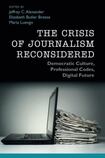
The separation of media studies from sociology hasn’t helped to throw light on the state of journalism. The apparent crisis of the profession often seems to be reduced to technological matters and to the question of how to best manage information overload: what to do about the acceleration and virtual omnipresence of information, and how to make sense of Twitter, Facebook, the number of reads (clicks), the endless stream of activists’ and politicians’ blogs or the noise that stems from constant media streaming. It often appears as if journalism’s purpose consists only in fairly reproducing the state of the world in miniature and, if possible, in an instant.
It is one of the great features of The Crisis of Journalism Reconsidered that it avoids such a narrow-minded focus. Its editors and contributors don't regard journalists as mere information-digesting machines. As Jeffrey Alexander's cultural sociological introduction makes clear, at the heart of the journalist's activity is performance, which involves contextualisation and, as part of that, interpretative skills such as "script reading", storytelling and meaning-making. Journalists do not just collect and distribute information in the shortest time possible, there are also ethics involved: one has to get the story right and attempt to be the first to break the news or print the story. This involves the ability to judge, usually under time pressure, and to discriminate between what seems fit to print or to be screened and what is not. The reduction of complexity must be achieved in such a way that it grasps the attention of readers, listeners or TV audiences, something news producers constantly compete for with other media outlets.
Journalists make normative assumptions concerning what a democratic public should look like, and in established democracies they usually work towards maintaining or helping to expand that sphere. Such expectations explain the tensions that some interpret as a permanent crisis. The present volume subjects this rhetoric of crisis to scrutiny. Looking at the matter performatively, it is suggested that journalists are at the crossroads of a number of demands; they are both interpreters and legislators and they appeal to norms or some moral sense. At the same time, the relations under which journalists work, and the means with which they perform, constantly change.
New technologies and the creative destruction they produce come into it, but this is not all there is to it, and not all such destruction amounts to genuine crisis. Michael Schudson, Columbia professor of journalism and media, and Nikki Usher, author of a book on New York Times reporting, show, for example, that most modern media outlets make hybrid use of a number of information sources, with some "scoops" being more successful than others. Indeed, as they also show, not a few journalists get stuck in "hamster wheels" (wasting valuable airtime or screen and print space for no information gain); such situations amount to news cul- de-sacs but hardly qualify as crises.
Cultural factors
To complicate matters, there are important cultural factors at play that might explain why the assumed crisis is not perceived equally in all countries. Rasmus Kleis Nielsen, from the Reuters Institute for the Study of Journalism, points out that, unlike most American newspaper or TV stations, publicly owned media in Scandinavia and other parts of Europe still depend largely on income from subscribers, regular readers or fee-paying audiences and state subsidies instead of private advertising.
Public spheres often reflect regional peculiarities and political cultures and sensibilities, as Spanish media expert Maria Luengo shows in her fascinating study of the reorganisation of New Orleans’s most important print outlet in the wake of Hurricane Katrina. Similarly, cultural codes and customs are at play when it comes to public readiness to engage with modern media technology, as Albany-based Matthias Revers reveals in his comparison of the media landscape of the US and Germany. Different democratic and cultural notions also find expression in such forms as citizen journalism, as discussed critically in another contribution by Swedish scholar Peter Dahlgren. Activists should take note: injecting fresh information by means of participant observation does not always produce good journalism, despite best intentions.
This collection proves that a discussion about journalism’s democratic function and performance is not something that should be left merely to practitioners, technology experts or academic mini-publics. Its advantage is that it opens a new space for discussion, and it is a new start that allows for a change of perspective.
Of course, not everything can be said in one volume. Missing in this collection are, for example, more historically grounded accounts of the profession; it suffers somewhat from sociological “presentism”. More could be said about the work of those journalists who passionately defend the notion of the civil sphere and whose life is often in danger; from Syria to Mexico there is plenty to report and discuss. Perhaps most surprising is that there is little or no discussion of such things as quality (we are never told what makes for a good article, report or feature); style (news content needs to find an adequate form); or language issues (minority-majority tensions, language groups, and questions such as who reports to whom and in what language, are crucial to any serious journalist undertaking).
Andreas Hess teaches sociology at University College Dublin. His book Tocqueville, Beaumont and the Birth Pangs of Modern Democracy is due to be published by Palgrave Pivot in the spring of 2017

